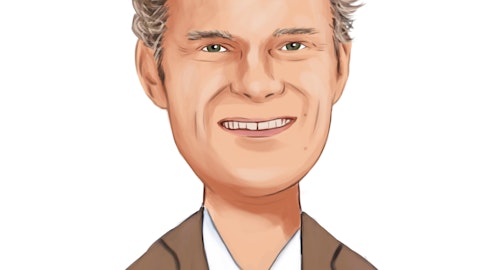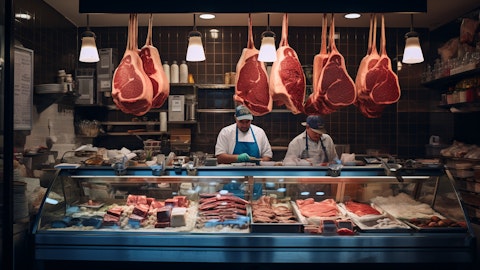David Flitman: Yes. I think the health is very solid. We’ve had some foot traffic challenges through the course of the third quarter there, particularly with the chains, which continued to see lower foot traffic sequentially, while our results improved. I think the health of the independent is very stable. And as you’ve heard me say in the past, I believe they’re going to win out in the long run here. And importantly, we continue to have a differentiated model that enables us to continue to take market share and support their businesses, not only with our great products and service with our people, but also our technology. So we think we’re differentiated there and regardless of what’s going on in the macro, we’re going to continue to penetrate that healthy customer base.
And importantly, I think overall, there’s less restaurants out there than there were pre-pandemic. But we’ve seen sequentially new openings of restaurants. And I would say our penetration is largely probably equally split between new openings of locations, as well as penetration and taking share from others in the marketplace. So it’s a pretty well-balanced approach at this point. I would expect to see continued openings in locations through the course of the next few quarters here. So we’re seeing that part of the customer base pretty healthy and stable.
Peter Saleh: Great. Very helpful. And then just on the indirect spending. I think you guys have mentioned past couple of quarters, some cuts that you would be making there. Can you just talk to us a little bit about where the progress is on some of those indirect spending cuts? Is that more of a 2024 event? Or have you started cutting some of those expenses? Thanks.
Dirk Locascio: Good morning, Peter. We have started to see some small savings begin to accrue already. We do expect that to accelerate as we go through 2024. But that’s moving along well and really as we planned. So it’s good to see some things come to fruition now, but more to come next year.
Peter Saleh: Thank you very much.
David Flitman: Thanks.
Operator: We’ll take our next question from Alex Slagle with Jefferies.
Alexander Slagle: Thanks. Congrats. I wanted to follow-up, it looks like the gap between the chains and independents slightly narrowed a bit quarter-over-quarter. I mean, is there any stabilization or relative improvement in the chains that you’re seeing or any more improvements to come, you think?
David Flitman: Well, I think just broadly in the market, the foot traffic was slightly down sequentially Q3 to Q2. And as I’ve said in the past, really the performance is relative to who you have in your portfolio relative to the winners and the folks who are going as well. We outperformed what was going on with foot traffic this quarter. I think that’s relatively stable. We have some things in the pipeline and I think we’ll continue to show improvement through the course of time and into next year, middle of next year. We’re targeting the right change that we believe are going to win. And as we’ve said in the past, we’ll continue to look for optimization opportunities within our portfolio.
Alexander Slagle: A question on Pronto. I guess it’s grown to cover about 35 markets now. What’s the broader TAM of this opportunity sort of where it can go and timeline to think about?
Dirk Locascio: Yes. We made aggressive investments in Pronto. You’ll continue to see us do that as an opportunity to serve our customers better. The frequency of deliveries, particularly in these urban areas that are difficult to reach. Customers want fresh products delivered more frequently, and that’s the great platform for us to do that. So we’ll continue to be thoughtful about where we take it but we see a long runway of opportunity there to continue to penetrate across our portfolio with Pronto. We love that model. We’re excited about it, and it’s getting great traction.
Alexander Slagle: All right. Thank you.
David Flitman: Thank you.
Operator: We’ll take our next question from Lauren Silberman with Deutsche Bank.
Lauren Silberman: Thank you. And congrats on the quarter. I wanted to ask about capital allocation. So $250 million or so in buybacks year-to-date, stock trading at a big discount to history, had really strong fundamental momentum. So can you expand on your willingness to further lean in how you’re thinking about capital deployment and allocation of buybacks versus M&A or debt paydown? And then specific to M&A, just how you think about the most accretive opportunities for the business.
David Flitman: Yes. So let me start to say we will always invest in organic growth in our company first. We think that’s the highest return and supporting our customers is paramount. We continue to look at expansion opportunities across our network, and we’ll be thoughtful about those, but we’ll continue to drive that first. And as you heard me say, we don’t need to do any acquisitions in this company. I love our footprint. We’ll take opportunities like we did with Renzi and the one we announced this morning to help us with efficiencies, taking miles out of the system and local market density. So let me just say a word about Saladino’s since you brought up M&A and the way we think about it. We’re very excited about that acquisition.
We said $600 million in revenue. It gives us an opportunity in the Central Valley where Saladino’s is roughly half chain and half independent, where we don’t have a footprint to serve the independent customer in that Central Valley, really none of our competitors do. So we’re excited about it from that standpoint. We’re excited about it from the standpoint of helping us optimize the chain business that we have in that Central and Northern California footprint. So we’ll take miles out and serve that part of the customer base better. But I guess I would say I’m most excited about the multiple we’re paying for that, which is a fraction of what we paid for Renzi, and a fraction of our trading multiple. So as we said, we will be thoughtful and disciplined about any acquisitions, and we won’t do any that don’t make sense, and we won’t overpay for them.
And Saladino’s is another great example of that. In terms of your question around share repurchases, we’re obviously under trading our potential and hugely undervalued in my view. You’ve seen us ramp up our share repurchases. I think we’ll be thoughtful about that going forward. Returning capital to shareholders is important. After we do the things we need to make sure we’re growing and supporting our customers well. Obviously, more to come on that through the course of time. But we’ve been leaning in hard on share repurchases, and we’ll continue to do that.
Lauren Silberman: Great. Thank you for that. And then just a follow-up, really impressive case growth trends. Can you talk about anything around the cadence of trends you saw throughout the quarter? And to the extent you’re willing to provide any color on October? And similarly, anything you can provide on – you saw inflation throughout the quarter and trends into October? Thank you.
David Flitman: Yes. Thank you. I think sequentially through the quarter, we saw things soften a bit in the market, as I said earlier. And that’s why I’m so excited that our independent case growth actually accelerated sequentially from Q2 to Q3, and we continue to accelerate our market share gains. So it underscores the importance of the differentiated model and the differentiation that we have actually in the marketplace. And in terms of the start to the fourth quarter, I think it’s largely in line with what we saw in Q3. I would say October started a little slower for us as we were lapping a strike from one of our large competitors in the first couple of weeks of October. We saw that volume bounce back as we would expect in the back half of the quarter, and we expect to be relatively in line with Q3 and importantly continue to take market share in those target customer types.
Dirk Locascio: Okay. On deflation. So we actually saw the year-over-year deflation improved or lessen as we went through the quarter. And in October, we actually saw a modest year-over-year inflation. And the improvements are primarily coming from center-of-the-plate. So as that begins to become modestly inflationary and then grocery is still very modest, but levels of inflation. So we think that’s encouraging.
Lauren Silberman: Thank you guys very much.




